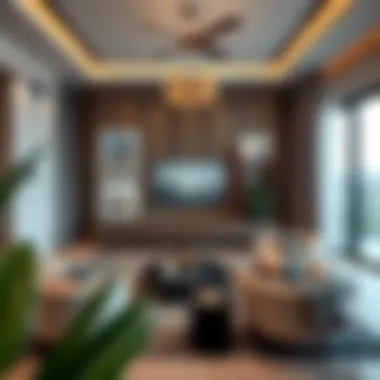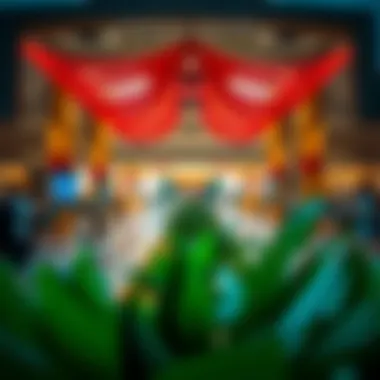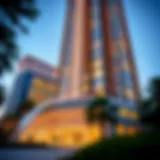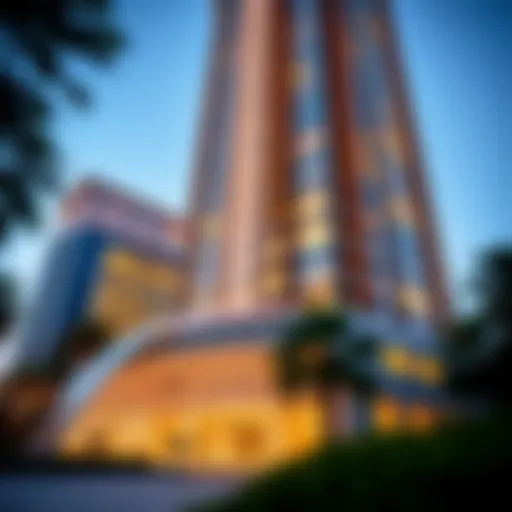The Role of Interior Designers in Dubai's Real Estate


Intro
Dubai’s real estate market is a vibrant and dynamic ecosystem, characterized by its breathtaking skyline and luxurious properties. However, beyond the glimmer of glass and steel lies the intricate world of interior design, which plays a pivotal role in shaping the market and enhancing the lifestyle of its residents. As the city continues to attract a diverse population, the need for personalized spaces has surged, paving the way for innovative designers to emerge and redefine the standards of luxury living.
Interior designers are not merely decorators; they are visionaries who marry functionality with aesthetics. Their work influences property values, buyer preferences, and even the overall architectural landscape of Dubai. With every project, they bring unique perspectives, reflecting the cultural tapestry of the city and its inhabitants.
This article aims to dissect the multifaceted role of interior designers in Dubai's real estate arena. We will explore current market trends, investment insights, and how the collaboration between designers and architects creates spaces that resonate with potential buyers. By the end, readers will have a deeper understanding of the powerful impact that interior design has on Dubai’s property market and lifestyle choices.
Prelims to Interior Design in Dubai
When one thinks about Dubai, the first images that come to mind are often its towering skyscrapers and opulent shopping malls. However, the realm of interior design plays a crucial role in the overall fabric of the city’s real estate market. Interior design in Dubai is not merely about beautifying spaces; it is a pivotal aspect that influences property values, buyer preferences, and the lifestyle of its residents.
In this context, understanding the evolution of interior design presents a layered perspective on the city's growth. As Dubai has transformed from a quiet desert town to a bustling metropolis, so too has its approach to design. First and foremost, the significance of interior design cannot be overstated when one considers the city’s unique blend of cultures and traditions. With a population that resembles a vibrant tapestry, interior designers find themselves faced with the challenge of creating environments that resonate with diverse backgrounds.
Moreover, as the market continues to evolve, interior designers have become instrumental in creating spaces that not only showcase luxury but also serve functionality. For investors and homeowners alike, hiring a skilled interior designer can mean the difference between a property that is merely a shelter and one that exudes character and elegance. The thoughtful arrangement of spaces can lead to a compelling first impression, which is critical in a market as competitive as Dubai’s.
Key Elements of Interior Design in Dubai
- Cultural Sensitivity: Interior designers often weave elements of local heritage into their projects, creating spaces that honor the culture.
- Luxury and Comfort: The emphasis on high-end materials and finishes reflects the city's affluence.
- Functional Spaces: Effective design accommodates the lifestyles of diverse residents, ensuring that homes are not just beautiful but practical.
As we delve deeper into this topic, we will explore the historical context of interior design in Dubai and how it has shaped the current landscape. Additionally, the emergence of modern design firms showcases a shift towards innovative solutions tailored to a discerning clientele.
"Interior design is not just what it looks like; it’s how it makes you feel."
In summary, interior design is a fundamental aspect of the appeal and value of properties in Dubai, and its evolution is intrinsically linked to the city’s development. Understanding this evolution offers a clear lens through which investors, homeowners, and property managers can appreciate the profound impact of design on Dubai's real estate market.
Historical Context of Interior Design
Like many facets of life in Dubai, the history of interior design is rooted in storytelling. In the early days, interiors reflected the utilitarian needs of the indigenous tribes, favoring functionality over aesthetics. Simple, practical furniture made from local materials served the homes of its early inhabitants. This was a time when interior design was inseparable from daily life and survival.
Fast forward to the discovery of oil in the 1960s, and the narrative shifts dramatically. Wealth began to flow in, ushering in an era of rapid urbanization. During this period, Western influences, primarily through globalization, penetrated the local market. Designers began to introduce elements inspired by European and American styles, mixing them with traditional Arabic motifs. This fusion marked the beginning of a new chapter in Dubai's interior design.
As the city expanded with luxurious hotels and stunning residential complexes, interior spaces became canvases for the extravagant. Local architecture began to feature intricate carvings and luxurious textiles, reminiscent of the region's rich heritage but also showcasing contemporary design.
Evolution of Style
- 1970s-1980s: Introduction of international design firms.
- 1990s: The rise of opulence; heavy draping, ornate patterns.
- 2000s onwards: Minimalism begins to gain traction; focus on sustainability and eco-friendly materials.
The historical context lays a groundwork that highlights how interior design in Dubai has grown from practicality to a statement of identity and exclusivity. As designs evolved, so too did the expectations of homebuyers and investors, who began to see value not just in property itself but in the experience and lifestyle it encapsulated.
The Rise of Modern Interior Design Firms
In recent years, the landscape of interior design in Dubai has significantly transformed with the emergence of modern design firms. These companies bring fresh perspectives and innovative approaches that cater to a sophisticated clientele. Unlike the traditional firms of the past, today’s designers focus on harnessing the latest technologies alongside sustainable practices.
The progression of modern firms mirrors that of the city itself; they too are bold, ambitious, and unafraid to break norms. Designers are increasingly utilizing digital tools such as virtual reality and augmented reality to offer clients immersive experiences of their future spaces, transforming how decisions are made.
Key Characteristics of Modern Firms:
- Interactivity: Engaging clients in the design process using technology.
- Sustainability: Emphasizing eco-friendly materials and practices.
- Customization: Developing personalized designs that reflect individual tastes and lifestyles.
These modern firms are not just creating interiors; they are shaping lifestyles. As they embrace contemporary aesthetics while remaining sensitive to traditional elements, they embody the very spirit of Dubai as a melting pot of cultures. The demand for innovative designs, paired with the city's developmental aspirations, suggests that the role of interior designers will continue to be pivotal in the evolution of Dubai’s real estate market.
In summary, the historical context and the rise of modern firms provide a comprehensive foundation for understanding the current state of interior design in Dubai. We will now explore the key characteristics that define this vibrant field.
Key Characteristics of Dubai's Interior Design
In the realm of interior design, Dubai stands unique. The key characteristics of Dubai's interior design not only reflect the city's cultural richness but also its rapid evolution in a high-paced market. This fusion reveals preferences influenced by various global styles while honoring local traditions. Focusing on these characteristics is vital for investors and homebuyers looking to understand the ever-shifting dynamics of this flourishing market.
Fusion of Traditional and Contemporary Styles


Dubai's interior design scene is a brilliant tapestry woven from history and innovation. Old and new coexist, providing an ambiance that speaks to both the past and the future. For instance, you might find luxurious villas featuring mashrabiya latticework alongside minimalistic modern furniture. This mix creates individualized spaces that respect local heritage while appealing to diverse tastes.
Incorporating traditional elements into contemporary design is not just aesthetic; it serves as a bridge. This trend attracts buyers from various backgrounds, offering them a sense of belonging in this cosmopolitan city. The careful blend also encourages local artisanship, which can elevate projects from mere buildings to works of art. Each interior tells a story, making all the difference in property appeal.
Buyers may be more inclined to purchase a property that features these nuanced designs due to their unique character. Spaces that prioritize this fusion tend to command higher prices, impacting overall property value significantly. Investors should indeed pay attention to these details, as they represent lucrative opportunities in a market that continually seeks innovation rooted in tradition.
Sustainability in Interior Design
Sustainability has become a buzzword in various industries, but in Dubai's interior design scene, it has grown into a guiding principle. Integrating sustainable practices is not merely a trend—it's essential for the long-term viability of the industry and the environment. Designers are increasingly focusing on selecting eco-friendly materials, energy-efficient fixtures, and sustainable manufacturing processes, thereby impacting both the lifestyle of residents and the city's reputation.
Many projects now highlight natural light through large windows, using materials like bamboo, reclaimed wood, and recycled glass to craft interiors with a significantly lower carbon footprint. More than just ethical choices, these elements have a practical side, reducing operational costs and positively affecting property value over time.
Furthermore, as more people become conscious of their ecological impact, properties that embrace sustainability will likely attract a growing segment of environmentally aware buyers. This eco-conscious approach not only helps the planet but also creates a market differentiation; homes that encapsulate these values may sell faster and at a premium.
"As interior designers shift their focus towards sustainable practices, they're not just changing spaces—they're redefining lifestyles."
The emphasis on sustainability showcases a commitment to the future—one that resonates with investors looking for longevity in their property investments. Understanding these key characteristics can lead potential buyers and investors to make informed decisions that align with their values while potentially enhancing their return on investment.
The Role of Interior Designers in Real Estate Enhancement
Interior designers play a critical role in the ever-evolving landscape of Dubai's real estate market. Their work extends beyond simply beautifying spaces; it is interwoven with the very fabric of property value and buyer satisfaction. Understanding this dynamic is essential for investors, homebuyers, and property managers looking to navigate the complexities of the market.
The aesthetic appeal crafted by interior designers can significantly influence how a property is perceived. Curb appeal matters, but so does the ambiance inside. Spaces that resonate with elegance and comfort often command higher prices. Designers also bring a wealth of knowledge about materials, trends, and the latest technologies. Their expertise can transform even the most basic layout into a desirable haven, thus enhancing the overall marketability of the property.
Moreover, interior designers also contribute to the unique character of a space, which is especially important in a city as diverse as Dubai, where cultures blend seamlessly. By tapping into various design influences, they help create environments that speak to different demographics. Therefore, their role transcends mere decoration; it is about creating homes that potential buyers can envision themselves in.
Impact on Property Value
The connection between interior design and property value is undeniable. Well-conceived interiors not only improve livability but can also bump up a property's price tag. A professionally designed space that reflects current trends might appraise for significantly more than a comparable property lacking such attention to detail. In a city with a competitive real estate market like Dubai, where high-end apartments and luxury villas abound, the difference can be astronomical.
- Enhanced First Impressions: The saying goes, "You never get a second chance to make a first impression." This certainly applies to real estate. Properties with thoughtfully designed interiors are more likely to attract potential buyers and investors.
- Increased Marketability: Interior designers understand buyer psychology. They leverage this insight to create spaces that appeal to the emotional aspects of home-buying, thus improving marketability.
- Utility and Efficiency: Good design not only looks nice but also functions well. Designs that are efficient in space usage can add a level of convenience that many buyers look for, influencing their purchase decisions.
- Longevity of Value: Investing in quality interior design can protect and even elevate property values over the years. Properties that are built to withstand the test of time, both aesthetically and functionally, will remain sought-after in the market.
Catering to Diverse Buyer Preferences
Dubai's real estate market is as varied as its population; thus, catering to a broad spectrum of preferences is crucial. Interior designers offer insights into what different demographics desire from their living spaces, ensuring that properties resonate with potential buyers.
- Cultural Sensitivity: Given Dubai's rich tapestry of cultures, interior designers have the skill to incorporate elements that are culturally significant while ensuring modern living standards are met. This careful consideration broadens the appeal of properties.
- Adapting Trends: In a world where design trends can shift practically overnight, interior designers are adept at staying ahead of the curve, ensuring properties remain desirable. Whether it is eco-friendly designs or the latest in smart home technology, they know how to integrate these features effectively.
- Personalization Options: Buyers are increasingly seeking properties that reflect their individual taste. Interior designers facilitate this by offering custom solutions that enable homeowners to add their flair—from bespoke cabinetry to personalized color schemes.
- Flexibility in Design: The demand for multifunctional spaces has risen, particularly in urban environments. Designers are keen to adapt spaces for various uses, meeting needs of younger buyers, families, and retirees alike.
"The true essence of interior design is not just about what meets the eye, but how the design serves the inhabitant's needs and desires."
Collaborative Ventures: Designers and Architects
The significant interplay between interior designers and architects in Dubai’s evolving real estate market cannot be overstated. In a city where the skyline is continually rising, the collaborative efforts of these two professionals create spaces that not only look good but also function well. They complement each other’s expertise, leading to the generation of environments that reflect harmonic design principles while addressing practical needs.
Synergistic Approaches to Space Planning
In a fast-paced metropolis like Dubai, strategic space planning is crucial. Architects focus on the building's structure, ensuring it stands tall and robust against environmental factors. Interior designers, on the other hand, concentrate on the inside, cultivating an atmosphere that speaks to aesthetics and comfort. When these two domains converge, the results can be breathtaking.
Collaborative approaches often incorporate elements such as:
- Spatial Efficiency: A well-planned interior utilizing innovative design can maximize space, catering to both residential and commercial needs.
- User Experience: With combined insights, designers and architects can create fluid transitions between spaces, emphasizing usability and flow.
- Sustainability: Collaborative efforts can lead to the integration of eco-friendly materials and designs that meet sustainability standards without compromising on luxury.
The vibrancy of Dubai is echoed in these synergistic designs, crafting spaces that reflect the city’s diversity and dynamic lifestyle. Each project is a testament to the seamless blend of form and function.
Case Studies of Successful Collaborations
Several noteworthy projects in Dubai exemplify the fruitful partnerships between architects and interior designers. These case studies shine a spotlight on the impact of their synergy:
- Burj Khalifa Residences: Here, the architectural brilliance of Adrian Smith married with the interior design mastery of Giorgio Armani resulted in luxurious living spaces that exude sophistication. Each apartment reinvents grandiosity while ensuring comfort through thoughtful space utilization.
- The Address Downtown: This project showcases how teamwork between Emaar Properties' architects and various interior designers created a landmark hotel. The integration of traditional elements with modern aesthetics offers guests a unique experience, reflecting the cultural essence of Dubai.
- Al Wasl Tower: A striking example of collaboration where Zaha Hadid’s architectural vision was enhanced by an interior environment that prioritizes both functionality and artistic expression, creating a vibrant workplace atmosphere.
"In Dubai, successful collaborations between architects and interior designers not only elevate individual projects but also contribute to the city’s overall architectural narrative, crafting a continuous dialogue between the past and future."


These examples underscore the necessity of effective partnerships in achieving designs that resonate with both residents and visitors alike. As each realm of expertise intertwines, the results often exceed initial design expectations, forging spaces that stand the test of time.
Exploring Luxury and High-End Design Trends
Luxury interior design in Dubai represents more than just aesthetics; it is intertwined with the region's identity and lifestyle aspirations. In a city where the opulent splendor of skyscrapers meets exquisite cultural influences, interior designers play a vital role in shaping not only luxurious spaces but also the general perception of lifestyle amongst residents and investors alike. The results are spaces that not only elevate living but also substantiate real estate values and desirabilities, particularly in a market that often targets the wealthy or those inspired by a luxury lifestyle.
Services Offered by Interior Designers in Dubai
Interior design in Dubai is not just a matter of aesthetics; it's about crafting spaces that encapsulate the spirit of the city while meeting the functional needs of its diverse inhabitants. In the fast-paced real estate market of Dubai, interior designers hold invaluable expertise in enhancing a property's appeal and functionality, which can significantly impact buyer decisions and ultimately property values. Here’s a deeper dive into the services these professionals offer, shedding light on their importance in the residential and commercial sectors of Dubai's vibrant real estate landscape.
Residential Interior Design Services
Residential interior design services in Dubai focus on creating inviting and functional living spaces that reflect the personal styles and preferences of homeowners. These services are crucial for new homebuyers or those looking to renovate their existing homes.
- Space Planning: Interior designers assess the layout of spaces, optimizing flow and functionality. They know how to maximize space, making even a modest apartment feel roomy and practical.
- Color Consultation: Selecting the right color palette is essential. Designers often help clients to choose colors that not only suit their taste but also complement the architecture and natural light.
- Custom Furniture Design: Unique furniture pieces can transform a space. Many designers work with craftsmen to create bespoke furniture that fits perfectly within a specific area, enhancing both function and style.
- Lighting Design: Designers leverage lighting as a tool to set moods within a home. They strategize the placement and type of lighting to enhance the ambience, ensuring spaces don’t feel either cold or overly bright.
- Material Selection: Choosing the right materials has a profound impact on both aesthetics and durability. Designers guide clients through options, balancing factors like cost, maintenance, and style.
"Choosing a skilled interior designer can turn mere walls into a reflection of oneself, creating an environment where comfort married with design becomes a daily pleasure."
Through thoughtful execution of these services, interior designers ensure that residential spaces are not only livable but also attractive to potential buyers, thereby increasing property value and market appeal.
Commercial and Hospitality Design
In the context of commercial and hospitality design, the roles of interior designers further expand. They are essential in creating spaces that are not just beautiful but also functional and conducive to business success. Incorporating local styles and cultural elements can set establishments apart in a competitive market like Dubai.
- Brand Alignment: Designers collaborate with brands to incorporate visual identity into the design. This alignment creates a cohesive experience for customers from the moment they step inside.
- Functional Layouts: The layout is crucial in commercial environments. Designers must consider traffic flow, customer experience, and workplace efficiency, all while ensuring aesthetic appeal.
- Sustainable Design Practices: More businesses are prioritizing eco-friendly design. Designers in Dubai implement sustainable materials and practices that appeal to environmentally conscious consumers.
- Cultural Sensitivity: Given Dubai's rich cultural tapestry, interior designers must weave cultural elements into their designs, creating spaces that resonate with the local populace and international visitors alike.
- Project Management: For commercial spaces, adept project management is essential. Designers oversee timelines, budgets, and contractors to ensure projects are completed successfully and to the client's satisfaction.
By offering these extensive services, interior designers in Dubai play a pivotal role in redefining living and commercial spaces, pushing boundaries while respecting the vibrant cultural context of the city.
For those looking to explore more about the impact of interior design on real estate pricing and buyer preferences, resources such as Wikipedia and Britannica can provide additional insights.
The Process of Hiring an Interior Designer
Hiring an interior designer is a critical step for anyone looking to enhance their living or work space in Dubai. It’s not just about making a space look pretty; it's about optimizing it for function, comfort, and aesthetics in a market characterized by rapid growth and evolving tastes. A designer acts as a bridge between dreams and reality, ensuring that the client’s vision comes to life in a manner that balances personal style and practical considerations.
Initial Consultations and Assessments
The first step in hiring an interior designer often starts with an initial consultation. This meeting serves as a window into the client's desires, needs, and budget. A good interior designer will take this opportunity to ask a flurry of questions—everything from the preferred color palette to the overall mood a client wishes to create in their space.
During these consultations, the designer should also assess the existing space thoroughly. Is there enough natural light? What are the dimensions of the room? Are there architectural limitations to consider, such as load-bearing walls? All these details come into play as the designer begins forming a clearer picture of how best to transform the space.
"A designer doesn’t just create a beautiful space; they create a functional one that tells your story."
Besides the aesthetic, emotional and functional requirements of a space, this phase sets the groundwork for trust and collaboration. The client shares their thoughts, while the designer offers professional insight. Open dialogue is useful here. It's crucial for clients to feel comfortable voicing their ideas and concerns. This sets the tone for a productive working relationship moving forward.
Budgeting and Planning Strategies
Budgeting is perhaps the least glamorous yet most crucial element of the interior design process. Understanding how to effectively allocate funds ensures that both the designer and the client remain on the same page moving forward. Designers should offer clients a comprehensive breakdown of costs involved, including materials, labor, and any additional service charges. Transparency fosters trust.
When clients present their budgets, a designer can work collaboratively to maximize each dirham spent. For instance, if a client dreams of a marble countertop but their budget allows for laminate, the designer might propose a beautiful laminate that mimics marble, providing a stunning result without breaking the bank.
Strategy is essential. Here’s a simple breakdown of factors to consider:
- Prioritize Needs over Wants: Distinguishing between what’s essential and what’s merely nice to have can help to refine the budget effectively.
- Set Aside a Contingency Fund: It’s wise to set aside about 10-20% of the total budget for unexpected costs. This prepares clients for surprises that could arise during the actual installation or design changes.
- Incorporate Value Engineering: This is a design strategy focusing on functionality without sacrificing quality. Clients can discuss material options and design features that fit their budget but do not compromise on the overall look.
Ultimately, a well-developed budget and planning strategy not only leads to greater satisfaction with the final results but also avoids the client from feeling blindsided by unexpected expenses. Working with an interior designer in Dubai means navigating through various high-end materials and finishes; thus, it's vital to have a clear financial plan from the onset.
Cultural Influences in Dubai's Interior Design
Dubai's interior design landscape is inherently intertwined with its rich cultural influences. The fusion of traditions, beliefs, and customs from various communities enriches the aesthetics and functionality of living and working spaces. Its significance in this context can't be overstated; understanding how cultural elements shape design choices offers profound insights for investors, homeowners, and property managers looking to navigate this vibrant market.


Integration of Local Heritage
Integrating local heritage into interior design serves as a way to honor Dubai's roots while appealing to modern sensibilities. Traditional motifs, architectural details, and color schemes often pay homage to the region's history and folk art. For example, the use of Arabic calligraphy can be seen painted on walls or inscribed on furniture, providing a cultural significance that is both visually pleasing and rich in meaning. This not only attracts clients who cherish authenticity but also enhances the overall property value.
In practice, integration means incorporating elements like:
- Mosaic tiles that echo ancient design practices.
- Handcrafted furniture that reflects local craftsmanship.
- Textiles and fabrics inspired by the surrounding desert landscapes.
By helping represent a community's unique narrative, these design choices cultivate a sense of belonging for residents, creating spaces that feel both personal and culturally significant.
Reflecting the Diversity of Residents
Dubai is a melting pot of cultures, and its interior design reflects this remarkable diversity. As such, designers adapt their styles to resonate with the varying tastes and backgrounds of its residents. This responsiveness to cultural plurality represents an essential consideration when delving into Dubai’s interior design scene.
Each design project often incorporates:
- International styles commingled with local aesthetics, ensuring that every individual can see a piece of their cultural heritage represented.
- Flexible spaces that accommodate diverse lifestyles, making homes adaptable to both traditional and contemporary living practices.
- Collaborative design efforts where input from various communities shapes the final aesthetic.
Ultimately, catering to a global audience in a local environment can make all the difference. Designers who acknowledge and incorporate these cultural influences enrich the narrative of Dubai’s real estate, making it irresistible to potential buyers looking for more than just a structure.
"In a city as diverse as Dubai, the interiors become a reflection of its people, harmonizing various cultural identities into one cohesive space.”
In summary, recognizing and utilizing cultural influences in interior design not only elevates aesthetic appeal but also serves as a powerful marketing tool for developers and investors. It opens up opportunities for deeper connections with clients and fosters an environment that celebrates diversity.
Future Directions for Interior Designers
In considering the future paths for interior designers in Dubai, it's key to acknowledge the changing landscape of the city’s real estate market. With an influx of new developments, diverse clientele, and shifting aesthetics, designers have to adapt not only to trends but also to technological advancements, ethical considerations, and the growing demand for sustainability. Understanding these factors helps to contextualize the role interior designers will play in shaping residential and commercial spaces that align with the expectations of a contemporary audience.
Technological Innovations in Design
Technology in interior design has come a long way, and this evolution is particularly pronounced in a market like Dubai, known for its luxurious architecture and cutting-edge innovations. Today, designers are utilizing advanced software for creating 3D models, allowing clients to walk through digital renderings of spaces before they are constructed.
With tools like Virtual Reality (VR) and Augmented Reality (AR), designers can provide immersive experiences, giving clients a real sense of how their spaces will feel. Additionally, smart home technology is integrating with interior design, making spaces not only more aesthetic but also functional. Lighting, temperature control, and entertainment systems can all be controlled remotely, appealing to a tech-savvy demographic.
Moreover, eco-friendly technologies are becoming increasingly influential. Designers in Dubai are often at the forefront of incorporating energy-efficient materials and systems into their designs. Smart solutions like solar panels, water recycling systems, and sustainable materials will not just draw buyers but also potentially raise property value, considering the growing demand for sustainability in the marketplace.
"The most successful interior designs are those that blend creativity with smart technology, responding directly to the needs of the modern inhabitant."
Adapting to Market Trends and Client Needs
The demands of clients and market trends are in a constant state of flux, underscoring the necessity for interior designers to remain agile and perceptive. As Dubai continues to attract a diverse expatriate population, understanding the cultural influences and personal preferences of potential clients becomes critical.
Every buyer comes with their unique vision, whether influenced by their cultural background or lifestyle aspirations. The trend towards personalization in interiors means that designers must be capable of tailoring environments that cater to the specific desires of their clients.
Furthermore, the real estate market in Dubai is witnessing a shift towards more compact living solutions and multifunctional spaces. Designers are now tasked with optimizing smaller properties, ensuring that every square inch counts without compromising style or functionality. This requires not just creativity but an understanding of spatial economics, a skill that will become increasingly significant in a competitive market.
In addition, transparency and engagement are emerging as essential elements in the working relationship between designers and clients. Designers need to communicate effectively, offering insights into the design process while paying attention to feedback. This helps to create a collaborative environment where client satisfaction is paramount.
In essence, the future directions for interior designers in Dubai hinge on technological adaptation, understanding client diversity, and the willingness to evolve with market trends to create spaces that resonate with the lifestyle and values of the region’s residents.
Finale: The Lasting Impact of Interior Design in Dubai
In wrapping up our exploration, it's vital to highlight the profound impact of interior design on Dubai's real estate landscape. Designers have not merely reshaped spaces; they have fundamentally altered perceptions and expectations of luxury, functionality, and sustainability. As the city continues its rapid development, the role of these professionals will only grow more significant, becoming integral to the narrative of urban life here.
Summarizing the Importance of Designers
Interior designers in Dubai serve as the critical link between architecture and human experience. Their work transcends decoration; it involves creating spaces that reflect cultural narratives, enhance well-being, and maximize usability. The choices made by designers—from color palettes to layout and material selection—directly influence the overall ambiance of a property and its appeal to prospective buyers.
Their expertise contributes to value enhancement, ensuring that properties stand out in a crowded market. For investors, a well-designed space often leads to greater returns and faster sales. Homebuyers, too, benefit from thoughtful design tailored to their needs, fostering a sense of belonging and comfort. Ultimately, the impact is visible not just in aesthetics but in creating environments that resonate with the heart and soul of Dubai.
Future Outlook for the Industry
Looking ahead, the future of interior design in Dubai hinges on innovation and responsiveness to evolving consumer needs. Technological advancements are already reshaping design processes, with tools like virtual reality allowing clients to visualize spaces before they’re crafted. Environmental considerations are also set to grow, with a greater push towards sustainable materials and energy-efficient practices becoming the norm rather than the exception.
In addition, as the demographic landscape of Dubai continues to diversify, designers will need to adapt their visions to accommodate an even broader range of tastes and cultural influences. This adaptability will be crucial for catering to a more eclectic client base in a city known for its rich tapestry of cultures.
The interplay of these factors indicates a vibrant future for the industry. Interior designers are not just part of the backdrop; they are key players shaping Dubai's identity, ensuring that it remains a global hub of innovation and elegance in design.
"Interior design is about creating a lifestyle and sensibility that speaks to the city's past, present, and future."
To sum it all, the lasting impact of interior design in Dubai is clear: it enhances property values, enriches quality of life, and continually pushes the envelope of what is possible in residential and commercial spaces alike. Investors, homebuyers, and property managers alike should pay keen attention to these evolving dynamics as they navigate this dynamic market.















